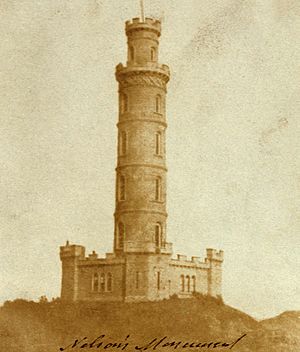Nelson Monument, Edinburgh facts for kids
The Nelson Monument is a special tower in Edinburgh, Scotland. It was built to remember a famous naval hero, Horatio Nelson. You can find it on top of Calton Hill. It looks impressive at the end of Princes Street.
The monument was built between 1807 and 1816. It celebrates Nelson's big win at the Battle of Trafalgar in 1805. He also died in this battle. Later, in 1852, a special "time ball" was added. This ball helped ships in Leith harbour know the exact time. The time ball works with the One O'Clock Gun from Edinburgh Castle. The monument was fixed up in 2009.
Every year on Trafalgar Day, special flags are flown from the monument. These include the Royal Navy's White Ensign. They also spell out Nelson's famous message: "England expects that every man will do his duty".
History of the Monument


The monument stands on the highest part of Calton Hill. This spot is about 171 meters (561 feet) above sea-level. Before the monument, a mast was here to send signals to ships.
People paid money to build the monument. The first design looked like a pagoda, but it was too costly. So, a new design was chosen. It looked like an upside-down telescope, which Nelson often used. This design was made by architect Robert Burn.
Building started in 1807. It was almost finished when money ran out in 1808. Robert Burn died in 1815. Thomas Bonnar then finished the base of the tower. This part has five sides and looks like a castle. It was completed between 1814 and 1816.
The tower was meant for sailors to live in and send signals. But by 1820, the ground floor rooms were a tea room. People could visit the monument for a small fee from the start. Later, the rooms were used by the monument's caretaker. In 2009, the tower was fully restored. This included fixing the stone and metal parts. The monument is a very important historic building.
The monument is 32 meters (105 feet) tall. It has 143 steps that lead to a public viewing area. The castle-like design matches the old prison buildings nearby.
Above the entrance, there is a special message. It remembers Nelson and his victory at Trafalgar. It also says that the monument teaches people to be brave and serve their country. Above this message is a stone carving of the San Josef. This was a ship Nelson captured in 1797.
The Time Ball
On top of the tower, you can see a time ball. This is a large ball that goes up and down to show the time. It was put in place in 1853 and started working in March 1854. Its job was to give a time signal to ships. This helped ships in Leith port and the Firth of Forth set their clocks.
The idea for the time ball came from Charles Piazzi Smyth. He was the Astronomer Royal for Scotland. The time ball was first connected by a wire to the nearby City Observatory. The company Maudslay, Sons & Field built the moving parts. They also built the time ball for Greenwich Observatory. James Ritchie & Son installed it. They still take care of the time ball today.
The ball is made of wood and covered in zinc. It used to weigh about 90 kilograms (200 pounds). The ball is raised just before 1 p.m. Then, at exactly 1 p.m., it drops from the mast. Many people thought it weighed much more, but that was a myth.
Later, in 1861, the One O'Clock Gun was set up at Edinburgh Castle. This gun provides a loud sound signal. It helps ships know the time when fog hides the time ball. The time ball worked for over 150 years. But a storm damaged it in 2007. In 2009, the time ball was taken down and fixed as part of the monument's restoration. It started working again on September 24, 2009. Now, the time ball is operated by hand. It drops when the One O'Clock Gun fires.




